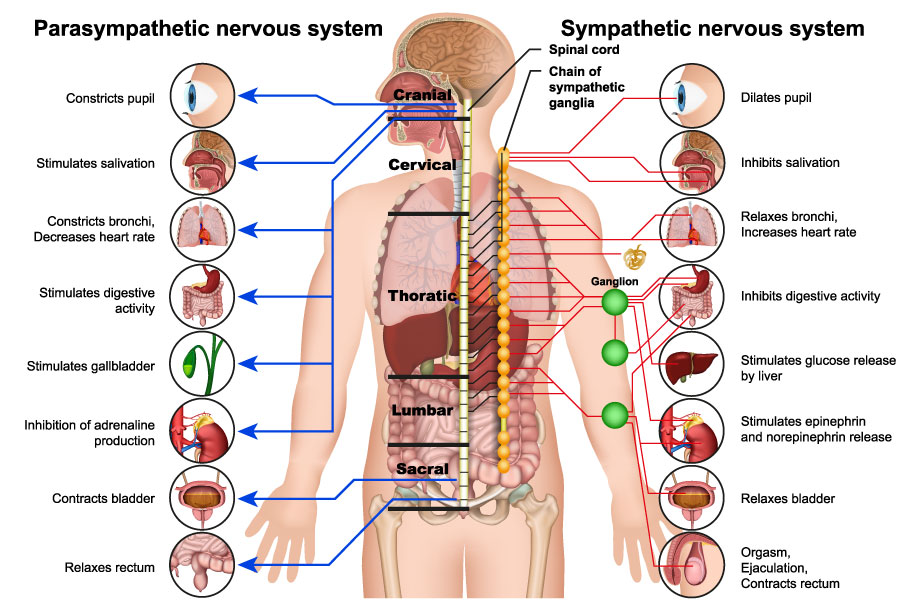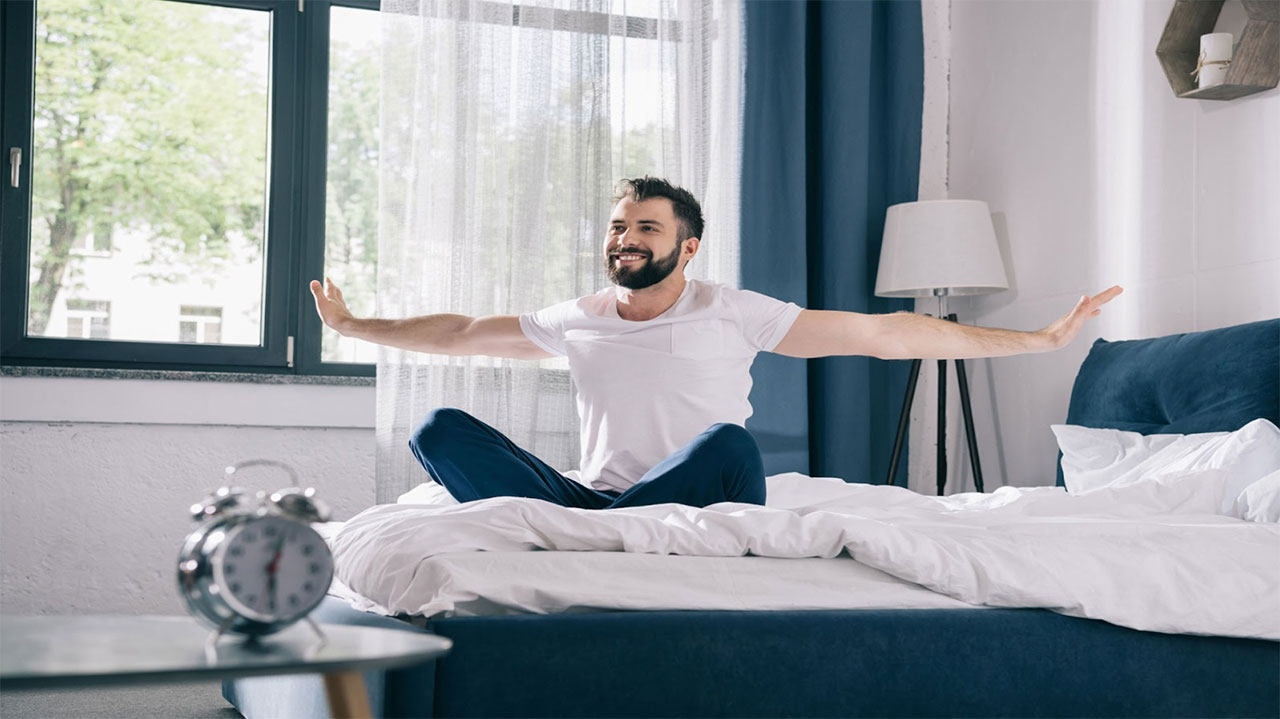Breathwork has been one of the most powerful tools I’ve learned for controlling my mental state.
I have found somatic breathwork to be really helpful to help me get out of my head by using simple rhythmic breathing patterns to slow my mind down and tap into the innate intelligence of my body.
One of the biggest problems that affects the health and well-being of people with ADHD is the over-activation of the sympathetic nervous system by chronic stress, high-pressure jobs, and stimulants.
The sympathetic nervous system is our stress response, often called the fight, flight or freeze response. While it is designed to help us respond to the fear of immediate threats, our brain and body react in the same way physiologically to anxiety.
The body’s physiological response makes no distinction between anxiety and fear. The result is that over time chronically high levels of stress and anxiety can lead to an over-activation of the stress response, which often results in low energy, chronic fatigue, depression and burnout.
The terms anxiety and fear are often used interchangeably. However, they are two related but distinct patterns of emotional response. Fear in the face of immediate danger is healthy and necessary but when anxiety that persists over time can have destructive effects on our physical and mental health.
According to Wikipedia, “Anxiety is distinguished from fear, which is an appropriate cognitive and emotional response to a perceived threat.” Now, anxiety itself is not necessarily a bad thing, in many ways anxiety is an inevitable part of taking risks and pushing beyond your comfort zone, but what’s important is you need to have tools to disarm and release it so it doesn’t become a chronic problem.
In this guide, I want to show how rhythmic breathwork training rooted in the ancient Pranayama tradition can be used to release stress and anxiety in your body and help you get to the root of problems with energy and focus.
How Somatic Breathwork Can Help ADHD
Many people I speak to who have ADHD say they can’t meditate. The problem with meditation is that if you have a lot of anxiety, depression or a busy mind, it can feel like torture. That’s where the rhythmic breathing of Pranayama comes in.
Pranayama is an ancient Yogic science based around using the breath to release stress and train your body physiologically to use energy more efficiently. The rhythmic breathing practices from this ancient Vedic tradition are great for people who struggle with sitting meditation simply because your mind can easily focus on the rhythm to go beyond the compulsive nature of thinking.
I have found the rhythmic breathing found in Pranayama breathwork helps me let go of thinking by giving my ADHD mind a structure to follow. This results in much less tension and emotional resistance to fully relaxing and feeling the “felt presence” of my immediate experience, which helps me get into a deeper state of meditation when I do a meditation practice afterward.
Without structure, it is very challenging to focus the ADHD mind. The initial practice of counting out your breaths and breathing in rhythm helps you quiet the compulsive chattering of the mind by giving it structure and logical consistency to fully relax and let go.
ADHD And The Shallow Breathing Epidemic
Every living being is guided by subtle natural rhythms and our body and brains naturally respond to rhythmic breathing. The natural way of breathing for all mammals is called eupnea, but in the modern world, very few adults still breathe this way.
If you look at a healthy child breathing, the breath naturally flows in through their nose and their belly rises as they can activate the diaphragm, which allows the breath to penetrate deeper into the lung tissue.
The difference among most adults with ADHD is their sympathetic nervous systems are constantly over-activated with anxiety, stimulants and stress. As a result, the slow rhythmic pattern of diaphragmatic breathing changes and breathing becomes more rapid and shallow.
The problem is over time, busy modern living in urban areas tends to lead to chronic shallow breathing, which makes it hard for the body to physiologically relax into what’s called the parasympathetic nervous system or the rest and digest response.

Another problem with high levels of stress, restlessness and tension in the body that is common in ADHD adults is it leads to mouth breathing.
This can be especially problematic when we are asleep and recharging at night as it can lead to a common problem that many people with ADHD struggle with called sleep apnea.
Sleep apnea is a sleep disorder that happens when your breathing stops and starts while you’re asleep. If it goes untreated, it can significantly worsen symptoms of ADHD, cause daytime tiredness and more serious problems like heart trouble or high blood pressure.
There is a growing body of research that suggests that chronic mouth breathing may lower cognitive performance and can aggravate symptoms of depression, anxiety, and attention deficit hyperactivity disorder (ADHD).
The goods news is you can easily diagnose shallow breathing by putting your hand on your stomach and chest. If you’re breathing into your chest then chances are you are shallow breathing.
You can start to change this through rhythmic breathing by keeping your mouth closed while slowing and lengthening the breath but you need to do Pranayama breathwork training systemically to re-train the nervous system.
How Somatic Breathwork Works:
Breath is the bridge which connects life to consciousness, which unites your body to your thoughts. Whenever your mind becomes scattered, use your breath as the means to take hold of your mind again.
— Thich Nhat Hanh
I first learned how to do somatic breathwork training in Koh Phangan, Thailand when I took the Soma Breath instructor certification course in the spring of 2018.
The teacher Niraj Naik opened my eyes to the importance of the breathing rhythm and how deliberate somatic breathwork training can improve health and induce altered states of consciousness.
One of the main goals of Soma Breath is to correct your breathing so that your normal rate of breathing at rest is 5-6 breaths per minute. On average people breathe 10+ breaths per minute.
Slowing your breath can help protect you against disease, balance your emotions, and assist you in getting in a relaxed state of focus and concentration.
Here are some of the many benefits of somatic breathwork training:
- More efficient at using oxygen
- Increased mind-body connection
- Increased cardiovascular health
- More stamina and better endurance
- Reduced inflammation
- Better nervous system balance
- Deeper states of meditation
- Enhanced mental and physical resilience
- Reduced stress and anxiety
In the Soma instructor training, we learned how to do what’s called intermittent hypoxia training, which is a scientifically proven way to train your mitochondria to produce cellular energy more efficiently.
To do it in a somatic breathwork training regime, you need oximeter. The training process involves rhythmic breathing to energize your body followed by breath holds, what’s called Kumbhaka in Pranayama, which trains both your lung capacity and cellular responses.
Intermittent Hypoxia Training (IHT) has been shown to improve human performance by way of adaptation to reduced oxygen. It’s one of the reasons why many Olympic athletes train at high altitudes to improve their endurance.
ADHD And Releasing Into Flow States
One of the superpowers of ADHD is being able to get into flow states when you are doing meaningful and challenging work.
The only problem is that stress, procrastination and distraction is our kryptonite and it prevents the nervous system coherence we need to stay focused and release into flow states.
Learning to navigate through stress and anxiety is important for high performance and creativity, largely because anxiety is a barometer of how much you are challenging yourself.
To live a creative life with ADHD where you consistently push beyond your comfort zone, you must get comfortable breathing into anxiety and stress so you can release the tension into a state of flow.
Long before Mihaly Csikszentmihalyi developed flow psychology in the 1970s, the ancient Indian Yogis were masters of flow and they developed a science of the inner world in the Vedas.
Eastern philosophy extensively documents the dangers of stress, anxiety, and a way of life that is out of balance with natural rhythms. The Vedic path toward restoring this delicate natural balance was through Yoga, which essentially means to restore Union with life and the Universe.
Beyond the Asanas, which are an important part of the 8 Limbs of Yoga that were codified In Patanjali’s Yoga Sutras, there were many more levels of training necessary.
Pranayama is the 2nd Limb of Yoga because it provides a way to train the spirit because breath is so foundational to spirit. The English word spirit actually comes from the Latin root spiritus, which means breath, life, and courage.
When we breathe naturally as nature intended, it frees us from the tension of anxiety and stress. Overlooked by modern medicine, harnessing the power of the breath can give a sense of control over your mind and body which frees you from the cycle of anxiety and overthinking.
Breathing away stress and anxiety through somatic breathwork training is the most effective method I’ve found for calming my restless ADHD mind.
Give it a try and I believe you will find that it is a vital practice for getting into flow and consistently achieving an optimal state of consciousness where you can feel and perform your best.




